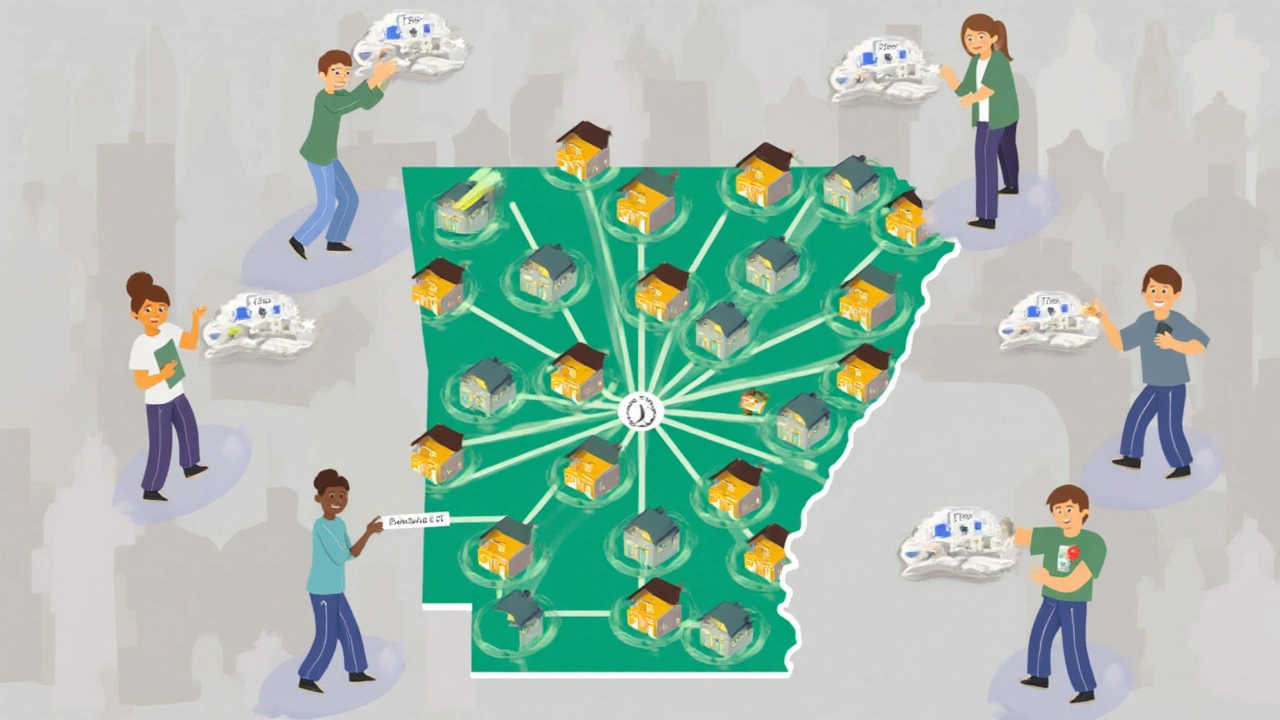
- Created by: Lydia Carmichael
- Completed on: 31 Jan 2025
- Categories: Homeless Support
Arkansas, like many other states, has faced the complex challenge of homelessness for years. In its pursuit to find effective solutions, the state has introduced a funding program known as the Go Grant. This grant is more than just financial aid; it's a beacon of hope for many organizations striving to make a difference in the lives of those without a home.
The Go Grant supports homeless shelters by providing them with the necessary resources to enhance their services and reach. These funds are pivotal in helping shelters not only maintain but also improve their ability to serve the community. Such backing allows for improvements in both infrastructure and service offerings, which can include anything from additional beds to comprehensive rehabilitation programs.
- Introduction to the Go Grant
- Eligibility and Application Process
- Impact on Homeless Shelters
- Success Stories and Challenges
- Future of Homeless Support in Arkansas
Introduction to the Go Grant
In Arkansas, the Go Grant emerges as a cornerstone funding initiative designed to combat homelessness by empowering shelters with the resources they need to operate effectively. Established with the vision of reducing homelessness across the state, this grant underscores the emphasis Arkansas places on providing adequate and meaningful support to its vulnerable populations. The Go Grant serves not just as a financial aid tool but as a catalyst that drives significant improvements in the capabilities of homeless shelters.
The mechanics of the Go Grant are firmly rooted in its eligibility criteria and application processes, designed to ensure that funds are directed where they are most needed. Typically, shelters that apply must demonstrate not only their need for support but also a comprehensive plan on how they intend to utilize the funds to increase their impact. This ensures the grant promotes accountability while inspiring innovation in approaches to care and service delivery among shelters.
As a result of the Go Grant, many shelters in Arkansas have reported substantial improvements in their service capacity. An increase in available beds, enhanced facilities, and even the expansion of holistic support services such as counseling and job training have been among the noted outcomes. A survey conducted in 2023 highlighted that shelters with access to the Go Grant were able to serve 25% more individuals compared to those without such resources. This reflects the immense potential of the grant to impact the well-being of the homeless population at large.
As Lila Alvarez, the director of a local shelter, remarked in an interview, "The Go Grant has transformed our operation. With it, we've not only expanded our physical space but also enriched the type of support we offer. It's been a lifeline for those we serve."
"The Go Grant has illuminated new possibilities for shelters, allowing them to dream bigger and deliver more for the communities they're a part of." – State Department of Human Services Official
Even with these successes, the grant is not without its challenges. Shelters often face intricate hurdles when it comes to aligning their plans with the grant’s stipulations. Yet, these challenges also bring opportunities for shelters to refine their services and create robust, sustainable models of care. As Arkansas continues to refine the Go Grant program, it serves as a model for other states looking to bolster their support for the homeless. In essence, the Go Grant is not merely a funding initiative; it signifies hope and a movement towards a future where every Arkansan has a place to call home.
Eligibility and Application Process
The Go Grant stands as a vital lifeline for homeless shelters across Arkansas, providing a path to secure funding that can revolutionize their operations. Navigating the eligibility criteria and the application process is crucial for shelters hoping to benefit from this initiative. To be eligible, organizations must typically be registered non-profits operating in Arkansas, specifically focused on providing services to the homeless population. These organizations also need to demonstrate a concrete plan for utilizing the funds effectively to enhance their impact on homelessness.
Applying for the Go Grant involves several meticulous steps. Applicants start by gathering thorough documentation of their current operations, which includes financial statements, proof of non-profit status, and detailed descriptions of the services they provide. It's important to showcase how the grant will play a pivotal role in expanding their reach and improving services. The application often requires a comprehensive proposal outlining the intended use of funds, projected outcomes, and a timeline.
The Arkansas Department of Human Services generally manages the Go Grant process. They host periodic workshops and webinars to assist potential applicants, ensuring a clear understanding of the process. Applicants can also benefit from these sessions by gaining insights from previously successful applicants. A touch of inspiration can be found in the words of Jane Hope, director of a shelter that thrived after receiving the grant:
"The Go Grant not only helped us keep our doors open but allowed us to serve our community with dignity and pride."
Practical Steps for Application
Successful applications begin with a thorough assessment of the shelter's needs and potential areas for improvement. This assessment leads to creating a compelling case for funding, often in the form of a detailed business plan. Once the groundwork is laid, organizations can proceed to complete the application form, ensuring all required documents are attached. It's advisable for shelters to read through the eligibility guidelines carefully to avoid any disqualifications due to minor oversights.
Throughout the application period, organizations are encouraged to maintain open communication with the grant administrators. Assistance is usually available, and reaching out with questions can prevent common pitfalls. The application window can vary, so keeping track of submission deadlines is vital. The competitive nature of the Go Grant means that timeliness and accuracy can make a significant difference in the decision-making process.
Once submitted, the review process starts with an assessment by a panel of experts who evaluate each application based on merit, need, and potential impact. Though waiting for the results can be a nerve-wracking period, the thorough review ensures that funds are allocated to those truly in need. If successful, shelters receive a notification outlining the next steps, always with a spirit of collaboration and mutual goal of addressing homelessness effectively.

Impact on Homeless Shelters
When it comes to tackling the issue of homelessness, funding is often the lifeline that sustains shelters across the nation, particularly in Arkansas. The Go Grant stands as a pivotal support system for homeless shelters within the state, offering them the financial means to enhance and expand their operations. This grant directly impacts the capacity and capability of these vital organizations by providing the necessary funds to address their most pressing needs. Many shelters, previously limited in their reach, have employed the funds to increase their bed capacity, ensuring that fewer individuals are turned away due to lack of space.
But the grant’s impact stretches beyond simple numbers. It paves the way for shelters to engage in structural improvements and service expansions that are often neglected due to budget constraints. For instance, shelters have been able to upgrade their facilities, providing cleaner and safer environments for residents and staff alike. These improvements not only make shelters more accommodating but also help restore dignity to those they serve. By addressing essential infrastructure needs, shelters can offer a more comprehensive suite of services, ranging from healthcare programs to counseling and job placement, tailored to aid individuals in regaining independence.
The Go Grant also enables shelters to invest in their staff, which is a crucial component often overshadowed by more immediate needs. Training and hiring more qualified personnel enhance the quality of care provided. The grant’s flexibility allows for tailored approaches, ensuring that each shelter can address its unique challenges. For instance, some shelters have initiated specialized workshops focused on community integration and skill development, which were previously unattainable due to limited budgets.
One cannot overlook the real, tangible outcomes stemming from this financial support. According to a report by the Arkansas Homeless Coalition, over 70% of shelters receiving the Go Grant funding report a notable increase in their service capacity, reflecting Arkansas’s strategic investment in combating homelessness. Moreover, a spokesperson from a prominent Arkansas shelter remarked,
"With the Go Grant, we've managed to turn a vision into a viable reality, enabling us to reach thousands more in need of assistance annually."These stories highlight the grant's profound influence on the community, a testament to its efficacy.
As significant as the impact is, challenges remain. The demand for shelter services often outpaces available resources, even with supplemental funding. Some shelters find themselves needing continued innovation in program delivery to keep up with the changing landscape of homelessness. Efforts to diversify funding sources aside from the grant are ongoing, with some shelters engaging in creative partnerships with local businesses and nonprofits. Additionally, continuous evaluation of services ensures that shelters remain adaptive to the evolving needs of their residents, maximizing the funding’s impact.
The Go Grant's role in transforming homeless shelters in Arkansas is a testament to the power of strategic funding in addressing critical social issues. While the journey to eradicate homelessness is far from over, the strides made possible through this grant bring hope and actionable progress to the forefront of community efforts.
Success Stories and Challenges
The Go Grant has been a transformative force for numerous Arkansas homeless shelters. Among these successes, one can certainly highlight the remarkable strides made by shelters like Haven House and Community Support Center. These shelters utilized the grant to significantly upgrade their facilities, allowing them to double their capacity and extend accommodations to families who previously had no access to such resources. With the additional funding, Haven House not only increased its bed count but also initiated an educational program for residents, focusing on practical life skills and employment readiness. This program has empowered residents to regain independence and reintegrate into society with confidence.
One can't ignore the success that Community Support Center achieved by expanding its mental health services. This was a dire necessity, as mental health challenges often accompany homelessness. Through the Go Grant, this shelter was able to partner with local health professionals to provide on-site counseling and therapy, which has been a game-changer for many individuals struggling with mental health issues. The impact of these services has been profound, with the center reporting a steady increase in successful transitions of residents to permanent housing.
While the triumphs are noteworthy, it is essential to also recognize the ongoing challenges that persist in the system. One significant hurdle is the limited reach, as not every shelter that applies for the Go Grant receives it due to resource constraints. The availability of funds, while helpful, is often not sufficient to meet the growing demands of all shelters across the state. Additionally, the bureaucratic processes involved in applying for and managing the grant can be cumbersome, often requiring shelters to dedicate significant time and resources, which they might otherwise use directly for their programs.
"The Go Grant has been a lifeline for our operations," says Mary Sanders, director of Haven House. "But the administrative work involved in securing and managing the funds can sometimes be as overwhelming as the challenges of homelessness itself."
In understanding these dynamics, it becomes apparent that a balance must be struck between providing adequate financial support and streamlining processes for ease of access and management. There is also a pressing need for continuous advocacy to increase the funding pool, enabling a broader implementation of successful initiatives. With a vision for a more equitable distribution and streamlined functionality, the Go Grant has the potential to make an even more lasting impact in the state of Arkansas. These enhancements not only benefit the logistical aspects but also fortify the human element, ensuring every resident has a fighting chance at rebuilding their lives.

Future of Homeless Support in Arkansas
The future of homeless support in Arkansas is shaping up to be a narrative of proactive strategies and community collaboration. With the ongoing challenges posed by economic changes and housing shortages, Arkansas is employing various techniques and policies to better address the needs of its homeless population. The cornerstone of these developments is the unwavering commitment to not only provide shelter but also foster long-term solutions that include affordable housing, job placement, and mental health support.
One pioneering approach being implemented is the expansion of the Go Grant initiative itself. By broadening the eligibility criteria and increasing the fund allocations, Arkansas aims to empower more organizations to participate in this crucial program. This expansion is seen as a necessary step to accommodate the ever-growing demand for resources and services. It signals an optimistic shift where more shelters can gain the necessary support to sustain and uplift the vulnerable communities they serve.
Another significant aspect of future strategies involves technological integration. Many shelters are looking toward digital solutions to streamline operations and enhance service delivery. This includes using data analytics to better understand trends and allocate resources effectively. The promise of technology lies in its potential to connect shelters with partners, donors, and volunteers more efficiently, creating a symbiotic network of support. An expert noted that "harnessing technology could revolutionize how we approach homelessness, making interventions timely and impactful."
Dr. Emily Ford, a sociologist specializing in housing policy, remarked, "The success of future homeless interventions hinges on our ability to combine empathy with innovation. Arkansas has the opportunity to lead by example."
Educational programs also stand at the forefront of future plans. By equipping those experiencing homelessness with job-ready skills, the state endeavors to break the cycle of poverty. Collaborations with local businesses and educational institutions are set to yield job training workshops and learning centers within shelter facilities. These efforts are designed to not only provide immediate relief but to empower individuals to rebuild their lives with dignity and independence.
Innovative housing models known as "tiny home communities" are gaining traction in the region. These initiatives aim to offer affordable housing to those who struggle with economic barriers. By optimizing space and resources, these communities present a sustainable alternative to traditional shelter models. Such tailored approaches are part of a larger conversation about customizable solutions that address specific community needs. A recent study underscored that these models could reduce overall homeless rates by 20%, adding substantial value to Arkansas's roadmap for the future.
Ultimately, the future of homeless support in Arkansas lies in its ability to adapt and evolve. As the state continues to foster partnerships across public and private sectors, the vision of a compassionate, accessible, and effective support system becomes a tangible reality. Through initiatives like the Go Grant and the exploration of new methodologies, Arkansas is paving the way for a future where homelessness is met with hope, resilience, and unwavering support.